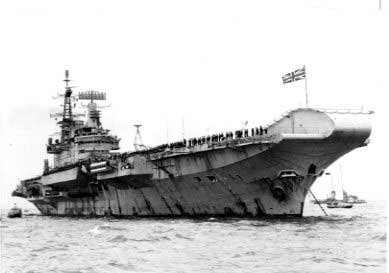In the event of the loss of a British carrier in the 1982 Falklands War, the U.S. was prepared to loan a helicopter carrier to the U.K. Royal Navy.
Collected are the entries from the 1982/1983 Combat Fleets of the World of the British carriers and the ship the U.S. had prepared to loan the Royal Navy.
USS Iwo Jima (LPH 2)
![USS Iwo Jima underway in 1984[U.S. Naval Institute Archives]](https://news.usni.org/wp-content/uploads/2012/06/webUSS-Iwo-Jima-LPH-2-1984.jpeg)
[U.S. Naval Institute Archives]
Laid down: 2-4-69
Launched: 17-9-60
In service: 26-8-61
Displacement : 11,000 tons light (17,515-18,300 fl)
Speed: 23 kts
Dimensions: 183.6 (169.5 wl) × 31.7 (25.5 wl) × 7.9 (hull) meters
Armament: 4/76.2-mm DP (II × 2)—2/Mk 25 Sea Sparrow launchers (VIII x 2)
Aircraft: 20-24/ CH-46 helicopters 4/CH-53 heavy helicopters 4/HU-1 utility or AH-1 attack helicopters
Electronic Equipment: Radar: 1/LN-66, 1/SPS-10, 1/SPS-40, 1/SPN-10 or SPN-43
Electronic Counter Measures: WLR-6, ULQ-6, 4/Mk 36 SRBOC chaff TACAN: URN-20
Machinery: 1 set GT; 1 prop; 23,000 hp
Boilers: 4 Combustion Engineering (LPH 9: Babcock & Wilcox); 42.3 kg/cm2, 467°C
Electric: 6,500 kw
Manning: 47 officers, 605 men +190 officers, 1,900 Marines
Remarks: LPH 9 conducted V/STOL suitability trials during 1972 and for
several years thereafter operated up to twelve AV-8A Harrier. The
ships have also aeted as carriers for RH-53 minesweeping helicopters.
One folding side elevator forward, to port; one to starboard, aft of
the island; 70-m hangar. Excellent medical facilities (300 beds). LPH
9 has an ASCAC (Air-Surface Classification and Analysis Center).
LPH 12, to a slightly different design, carries two LCVP in davits.
Two Mk 63 gunfire control being removed. Two 20-m Vulcan/Phalanx AA to
be added.
HMS Invincible (R 05)
![HMS Invincible returns to the U.K. from the Falklands in 1982[U.S. Naval Institute Archives]](https://news.usni.org/wp-content/uploads/2012/06/webFalklands-Combat-Vessels-Returning-3.jpeg)
[U.S. Naval Institute Archives]
Builder: Vickers, Barrow
Laid down: 20-7-73
Launched: 14-12-78
In service: 11-7-80
Displacement : 16,256 tons (19,812 fl)
Speed: 28 kts
Dimensions: 206.6 (192.87 wl) × 31.89 (27.5 wl) x 6.4 (mean) meters
Armament: 1/Sea Dart GWS 30 system (II x 1; 22 missiles)
Aircraft: 5/Sea Harrier, 9/Sea King Mk 2
Electronic Equipment: Radars: 2/1006, 1/992R, 1/1022, 2/909
Sonar: 1/184, 1/762 echo-sounder, 1/185 telephone Data system: ADAWS-5
Electronic Counter Measures: passive; 2/Knebworth/Corvus RL
Machinery: 4 Rolls-Royce Olympus TM3B gas turbines; 2 props; 112,000 hp (94,000 sust.)
Electric: 14,000 kw
Range: 5,000 nautical miles
Manning: 131 officers, 869 men (plus 318 aircrew)
Remarks: Designated “ASW (anti-submarine warfare) aircraft carriers” in 1980, previously
having been, for political reasons, considered to be a type of
cruiser. Although all three are to be completed, only two will be
operational at any one time. Invincible, ordered 17-4-73 and intended
for V/STOL aircraft and helicopters only, has a flight deck 183 meters
long with an 8-degree “ski jump” at the forward end to assist Sea
Harrier aircraft in making rolling takeoffs at full combat load. The
flight deck on Ark Royal will be 12 degrees and is 10 to 12 meters
longer. The 183-meter long by 13.5-m wide flight deck is slightly
angled to port to clear the Sea Dart launcher, which is awkwardly
located on the ship’s centerline and has been given an elaborate blast
shield to protect the aircraft aboard. The single-level hangar has
three separate bays, with the amidships bay narrower to permit passage
of the gas-turbine exhausts. There are two 9.7 by 16.7-m elevators.
The Type 1022 long-range air-search radar uses a Marconi antenna but
has the same electronics as the HSA LW-08. Four MM 38 Exocet launchers
were deleted from the design. The electrical generating plant consists
of 8 General Electric 1,750-kw alternators driven by Paxman Valenta
16RPM 200A diesels of 2,700 hp each. The MADGE microwave landing
system is being installed.
HMS Hermes (R 12)

Builder: Vickers, Barrow
Laid down: 21-6-44
Launched: 16-2-58
In service: 18-11-59
Displacement: 23,900 tons (28,700 fl)
Speed: 28 kts
Dimensions: 226.85 (198.12 pp) × 48.78 (27.43 wl) × 8.8 meters
Armament: 1/Sea Dart GWS 30 system (II x 1; 22 missiles)
Aircraft: 5/Sea Harrier–12 Sea King Mk 2,4
Electronic Equipment: Radars:1/965, 1/978, 1/993, 2/903–TACAN Sonar: 1/184
Electronic Counter Measures: passive, 2 Knebworth/Corvus RL
Machinery: 2 sets Parsons GT; 2 props; 76,000 hp
Electric: 9,000 kw
Fuel: 4,200 tons plus 320 tons diesel
Manning: 143 officers, 1,027 men
Remarks: Converted 1971-73 by the Devonport Naval Dockyard into a helicopter carrying commando carrier (LPH). Converted again 1976/1-77 as an ASW carrier for Sea King and Wessex helicopters and converted 5-80 to 9-5-81 for operational employment of Sea Harrier V/STOL strike aircraft. She will continue in service until 1983 when Illustrious becomes fully operational. Hermes retains the ability to embark two commando groups (750 men) and continues to carry four LCVPs in davits, Catapults and arresting gear removed 1971. Flight deck angled 6.5 degrees and strengthened for Harriers, 12-degree “ski jump” takeoff ramp was fitted to her bow, weighing 230 tons and some 45.7-m long by 13.7-m wide by 4.9-m high.
In 1978 a Ferranti 1600E computer was added to aid in tactical data handling, and during the 1980-81 overhaul, U.S. satellite communications equipment was added, as was the MADGE microwave landing system and the HAPIS (Horizontal Approach Path Indicator System) for Sea Harrier.




